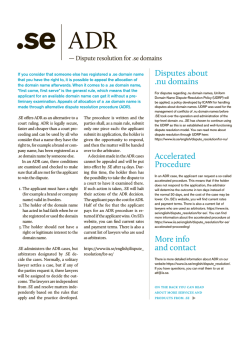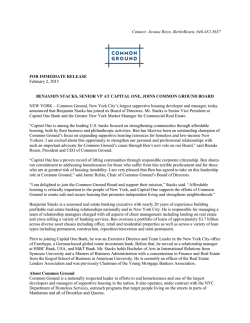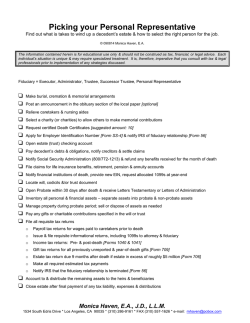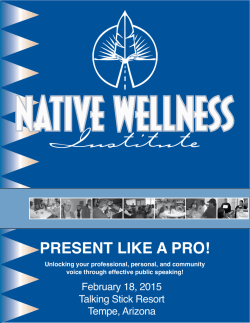
Information under Article 23 of European Alternative Investment
Disclaimer This document has been prepared solely for the purpose of providing Dutch investors with certain information under Article 23 of the European Alternative Investment Fund Managers Directive (European Directive 2011/61/EU) (the “AIFMD”) as implemented in the Netherlands. Accordingly, you should not use this document for any other purpose. The units of Advance Residence Investment Corporation (“ADR” or the “AIF”) are being marketed in the Netherlands under Section 1:13b of the Dutch Financial Supervision Act (Wet op het financieel toezicht, or the “Wft”). In accordance with this provision, AD Investment Management Co., Ltd. (the “AIFM”) has notified the Dutch Authority for the Financial Markets of its intention to offer these units in the Netherlands. The units of ADR will not, directly or indirectly, be offered, sold, transferred or delivered in the Netherlands, except to or by individuals or entities that are qualified investors (gekwalificeerde beleggers) within the meaning of Article 1:1 of the Wft, and as a consequence neither the AIFM nor ADR is subject to the license requirement pursuant to the Wft. The AIFM is therefore solely subject to limited ongoing regulatory requirements as referred to in Article 42 of the AIFMD. sf-3476691 Article 23 (1)(a) Objectives of the AIF Advance Residence Investment Corporation seeks to maximize unitholder value, aiming to secure stable profits and achieve asset growth over the medium and long term by investing in Japanese domestic real estate primarily used for residential purposes with a focus on diversifying its investments among regions. Investment strategy ADR’s investment strategy is to maximize unitholders’ value by utilizing ITOCHU Group’s and other supporting companies’ networks, knowledge and human resources in areas concerning leasing, property sourcing and facility management. Types of assets the AIF Real estate, trust beneficiary interests in real estate, real estate securities, specified assets may invest in and other assets. Techniques it may ADR focuses on investing in residential properties which ADR anticipates will provide steady employ and all rental revenue especially in Tokyo and other urban areas where there will be continued associated risks population growth even though the population as a whole is expected to decline. The principal risks with respect to investment in ADR are as follows: • any adverse conditions in the Japanese economy could adversely affect ADR; • ADR may not be able to acquire properties to execute the growth and investment strategy in a manner that is accretive to earnings; • illiquidity in the real estate market may limit the ability to grow or adjust the portfolio; • the past experience of the asset manager (the “AIFM”) in the Japanese real estate market is not an indicator or guarantee of the future results; • ADR’s reliance on ITOCHU Group, the AIFM and other third party service providers could have a material adverse effect on business; • there are potential conflicts of interest between ADR and ITOCHU Group as well as the AIFM; • ADR’s revenues largely comprise leasing revenues from the portfolio properties, which may be negatively affected by vacancies, decreases in rent, and late or missed payments by tenants; • ADR faces significant competition in seeking tenants and it may be difficult to find replacement tenants; • increases in interest rates may increase the interest expense and may result in a decline in the market price of the units; • ADR may suffer large losses if any of the properties incurs damage from a natural or man-made disaster; • most of the properties in the portfolio are concentrated in Tokyo metropolitan area; • any inability to obtain financing for future acquisitions could adversely affect the growth of the portfolio; 2 sf-3476691 • ADR’s failure to satisfy a complex series of requirements pursuant to Japanese tax regulations would disqualify ADR from certain taxation benefits and significantly reduce the cash distributions to the unitholders; and • the ownership rights in some of the properties may be declared invalid or limited. In addition, we are subject to the following risks: • risks related to increasing operating costs; • risks related to ADR’s dependence on the efforts of the AIFM’s key personnel; • risks related to the restrictive covenants under debt financing arrangement; • risks related to entering into forward commitment contracts; • risks related to third party leasehold interests in the land underlying ADR’s properties; • risks related to holding the property in the form of stratified ownership (kubun shoyū) interests or co-ownership interests (kyōyū-mochibun); • risks related to holding the property through trust beneficiary interests; • risks related to properties not in operation (including properties under development); • risks related to the defective title, design, construction or other defects or problems in the properties; • risks related to suffering impairment losses relating to the properties; • risks related to decreasing tenant leasehold deposits and/or security deposits; • risks related to tenants’ default as a result of financial difficulty or insolvency; • risks related to the insolvency of master lessor; • risks related to relying on expert appraisals and engineering, environmental and seismic reports as well as industry and market data; • risks related to the presence of hazardous or toxic substances in the properties, or the failure to properly remediate such substances; • risks related to the strict environmental liabilities for the properties; • risks related to the insider trading regulations; • risks related to the amendment of the applicable administrative laws and local ordinances; • risks related to infringing third party’s intellectual property right; • risks related to holding interests in properties through preferred shares of special purpose companies (tokutei mokuteki kaisha); • risks related to holding Japanese anonymous association (tokumei kumiai) interests; • risks related to investments in trust beneficiary interest; • risks related to the tight supervision by the regulatory authorities and compliance with applicable rules and regulations; 3 sf-3476691 • risks related to the tax authority disagreement with the AIFM’s interpretations of the Japanese tax laws and regulations; • risks related to being unable to benefit from reductions in certain real estate taxes enjoyed by qualified J-REITs; • risks related to changes in Japanese tax laws; and • risk of dilution as a result of further issuances of units. Any applicable ADR is subject to investment restrictions under Japanese laws and regulations (e.g., the Act investment restrictions on Investment Trusts and Investment Corporations (the “ITA”), the Financial Instruments and Exchange Act (the “FIEA”)) as well as its articles of incorporation. ADR must invest primarily in specified assets as defined in the ITA. Specified assets include, but are not limited to, securities, real estate, leaseholds of real estate, surface rights (chijōken) (i.e., right to use land for the purpose of having a structure on it) or trust beneficiary interests for securities or real estate, leaseholds of real estate or surface rights. A listed J-REIT must invest substantially all of its assets in real estate, real estate-related assets and liquid assets as provided by the listing requirements. Real estate in this context includes, but is not limited to, real estate, leaseholds of real estate, surface rights, and trust beneficiary interests for these assets, and real estate-related assets in this context include, but are not limited to, anonymous association (tokumei kumiai) interests for investment in real estate. Pursuant to the ITA, investment corporations may not independently develop land for housing or to construct buildings, but may outsource such activities in certain circumstances. Investment restrictions ADR places in its articles of incorporation are as follows: (1) Restrictions relating to securities and monetary claims ADR will place importance on stability and convertibility of investments into securities and monetary claims, and it will not make investments aimed only at gaining positive management profits. (2) Restrictions relating to derivatives transactions ADR will invest in rights associated with derivatives transactions only for the purpose of hedging against interest risks arising from ADR’s liabilities and other related risks. (3) ADR will restrict its real estate investment targets to real estate located in Japan. (4) ADR will not invest in assets denominated in a foreign currency. Circumstances in which ADR may take out loans or issue long-term or short-term corporate bonds for the purpose of the AIF may use investing in properties, conducting repairs and related work, paying cash distributions, leverage repaying obligations (including repayment of tenant leasehold or security deposits, and obligations related to loans or long-term or short-term corporate bonds) and other activities. 4 sf-3476691 The types and sources Loans or corporate bonds. ADR currently does not have any outstanding guarantees and may of leverage permitted be subject to restrictive covenants in connection with any future indebtedness that may and associated risks restrict the operations and limit the ability to make cash distributions to unitholders, to dispose of the properties or to acquire additional properties. Furthermore, ADR may violate restrictive covenants contained in the loan agreements ADR executes, such as the maintenance of debt service coverage or loan-to-value ratios, which may entitle the lenders to require ADR to collateralize the properties or demand that the entire outstanding balance be paid. Further, in the event of an increase in interest rates, to the extent that ADR has any debt with unhedged floating rates of interest or ADR incurs new debt, interest payments may increase, which in turn could reduce the amount of cash available for distributions to unitholders. Higher interest rates may also limit the capacity for short- and long-term borrowings, which would in turn limit the ability to acquire properties, and could cause the market price of the units to decline. Any restrictions on The maximum amount of each loan and corporate bond issuance will be one trillion yen, and leverage the aggregate amount of all such debt will not exceed one trillion yen. Any restrictions on No applicable arrangements. collateral and asset reuse arrangements Maximum level of ADR has set an upper limit of 60% as a general rule for its loan-to-value, or LTV, ratio in order leverage which the to operate with a stable financial condition. ADR may, however, temporarily exceed such AIFM is entitled to levels as a result of property acquisitions or other events. employ on behalf of the AIF Article 23(1) (b) Procedure by which Amendment of the articles of incorporation. Amendment requires a quorum of a majority of the AIF may change its the total issued units and at least a two-thirds vote of the voting rights represented at the investment strategy / meeting. Unitholders should note, however that under the ITA and our articles of investment policy incorporation, unitholders who do not attend and exercise their voting rights at a general meeting of unitholders are deemed to be in agreement with proposals submitted at the meeting, except in cases where contrary proposals are also being submitted. Additionally, the guidelines of the AIFM, which provide more detailed policies within ADR’s overall investment strategy and policy, can be modified without such formal amendment of the articles of incorporation Article 23(1) (c) Description of the ADR has entered into a sponsor support agreement with ITOCHU Corporation and ITOCHU main legal implications Property Development Co., Ltd governed by Japanese law. of the contractual relationship entered 5 sf-3476691 into for the purpose of ADR is not involved in or threatened by any legal arbitration, administrative or other investment, including proceedings, the results of which might, individually or in the aggregate, be material. jurisdiction, applicable law, and the existence or not of any legal instruments providing for the recognition and enforcement of judgments in the territory where the AIF is established Article 23(1) (d) The identity of the • AIFM (Asset Manager): AD Investment Management Co., Ltd. AIFM, AIF's depository, • Auditor: Deloitte Touche Tohmatsu LLC auditor and any other • Custodian and Transfer Agent: Mizuho Trust and Banking Co., Ltd. service providers and a • General Administrators: Sumitomo Mitsui Trust Bank, Limited description of their Service providers owe contractual obligations under their respective agreements with the AIF duties and the or AIFM, as the case may be. In addition, the FIEA provides that the Asset Manager owes the investors' rights AIF a fiduciary duty and must conduct its activities as the asset manager in good faith. thereto The FIEA also prohibits the Asset Manager from engaging in certain specified conduct, including entering into transactions outside the ordinary course of business or with related parties of the Asset Manager that are contrary to or violate the AIF’s interests. Pursuant to the ITA, the unitholders have the right to approve the execution or termination of the asset management agreement at a general meeting of unitholders. Article 23(1) (e) Description of how the Not applicable. AIFM complies with the requirements to cover professional liability risks (own funds / professional indemnity insurance) Article 23(1) (f) Description of any delegated management function such as portfolio Not applicable. There is no delegation of such functions beyond the AIFM, which is responsible for portfolio and risk management, and the Custodian, which is responsible for safekeeping activities. 6 sf-3476691 management or risk management and of any safekeeping function delegated by the depositary, the identification of the delegate and any conflicts of interest that may arise from such delegations Article 23(1) (g) Description of the AIF’s ADR makes investment decisions based on the valuation of properties, upon consideration of valuation procedure the property appraisal value. and pricing methodology, including the methods used in valuing hardto-value assets ADR shall evaluate assets in accordance with its Article of Incorporation. The methods and standards that ADR uses for the evaluation of assets shall be based on the Regulations Concerning the Calculations of Investment Corporations, as well as the Regulations Concerning Real Estate Investment Trusts and Real Estate Investment Corporations and other regulations stipulated by ITA, in addition to Japanese GAAP. J-REITs may only use the valuation methods prescribed in the rules of the Investment Trusts Association, Japan, which emphasize market price valuation. Please refer to ADR’s “Article of Incorporation of Investment Corporation, Attachment 2” (http://www.adr-reit.com/src/2013/12/Articles-of-Incorporation20131025.pdf). Article 23(1) (h) Description of the AIF’s ADR seeks to manage its capital resources and liquidity sources to provide adequate funds for liquidity risk current and future financial obligations and other cash needs and acquisitions. management, including redemption rights in normal and exceptional circumstances and ADR manages liquidity risk by preparing monthly cash management plans and by acquiring committed lines of credit from its major lenders. As ADR is a closed-end investment corporation, unitholders are not entitled to request the redemption of their investment. existing redemption arrangements with investors Article 23(1) (i) Description of all fees, Compensation: The articles of incorporation provide that ADR may pay its executive officer charges and expenses up to one million yen per month and each of its supervisory officers up to 500 thousand yen and a maximum 7 sf-3476691 amount which is per month. The board of officers is responsible for determining a reasonable compensation directly / indirectly amount for the executive officer and each of the supervisory officers. borne by the investors Asset Manager: • Asset Management Fee: ADR will pay the Asset Manager an asset management fee as follows: o Asset Management Fee 1 ADR will, within 2 months after the end of each fiscal period, pay an amount up to a maximum of the amount (calculated pro rata based on the actual number of days in the relevant fiscal period, taking one year as being 365 days; the same applies to calculations of the base fee below) calculated by multiplying by 0.20% p.a. the total asset value set out in ADR’s balance sheet (approved under Article 131, Paragraph 2 of the Investment Trusts Act) dated as of the closing of the latest fiscal period. o Asset Management Fee 2 ADR will pay, within 3 months after the closing of fiscal period, an amount not exceeding the amount calculated by multiplying the total of real estate rental business income (if invested assets include equity interests in silent partnerships or real estatebacked securities involving real estate, including the dividends relating to these invested assets or other forms of income) after subtracting the total of the real estate rental business expenses (excluding depreciation expenses and losses on the sale or retirement of non-current assets) for the relevant fiscal period by 3.0%. o Asset Management Fee 3 An amount not exceeding the amount calculated by the following method shall be paid within 3 months after the closing of fiscal period. Calculation formula: (Total of Asset Management Fee 1 and Asset Management Fee 2 for the relevant fiscal period) x adjusted EPU x 0.008% (Note) Where the adjusted EPU is to be calculated A ÷ B A: Net profit for the relevant fiscal period before deduction of the amount for Asset Management Fee 3 B: Number of units issued as of the closing date of the fiscal period (Note) From the first day of the fiscal period during which the application of Asset Management Fee 3 commences, the following are to apply: (i) if ADR implements a 1-for-X unit split, the amount calculated based on the formula above for Asset Management Fee 3 shall be multiplied by X for fiscal periods following the relevant fiscal period; and (ii) if ADR implements a Y-for-1 consolidation of the units, the 8 sf-3476691 amount calculated based on the formula above for Asset Management Fee 3 shall be divided by Y for fiscal periods following the relevant fiscal period. • Acquisition Fee When real estate or real-estate-backed securities are newly acquired, ADR will pay the Asset Manager, by the end of the month following the month of acquisition, an amount not exceeding the amount calculated by multiplying the purchase price of the asset acquired by 1.0%. The “purchase price” is the amount set out in the purchase agreement and excludes expenses associated with the purchase and consumption tax and local consumption tax. • Disposal Fee When real estate or real-estate-backed securities are disposed of, ADR will pay the Asset Manager, by the end of the month following the month of disposal, an amount not exceeding the amount calculated by multiplying the sales price of the asset so disposed of by 0.50%. The “sales price” is the amount set out in the purchase agreement and excludes expenses associated with the sales and consumption tax and local consumption tax. • Merger Fee If the AIFM conducts a survey or valuation of the assets held by a possible merger partner for ADR and ADR inherits these assets held by the merger partner through a merger, an amount multiplied by a rate not exceeding 0.5% of assets including real estate, real estate-backed securities, specified bonds, and real estate-related loans on the merger effective date shall be paid to the Asset Manager within 3 months from the end of month in which the merger effective date falls. Custodian: • Custodian Fee: ADR will pay the Custodian a monthly fee calculated as follows: The amount of total assets as indicated on the prior month-end trail balance x 0.03% ÷12 General Administrators: • General Administrators Fee: ADR will pay the General Administrators a monthly fee calculated as follows: 9 sf-3476691 The amount of total assets as indicated on the prior month-end trial balance x 0.09% ÷12 Transfer Agent: • Transfer Agent Fee (Standard Fee): Standard transfer agent fees are for services such as preparation, maintenance and storage of ADR’s unitholder register; preparation and reporting of the end-of-period unitholders register and unitholder statistical data. The monthly standard fees will be the total of the amount calculated using the following table divided by 6, with a minimum monthly fee of 200,000 yen. Number of Unitholders Fees per Unitholder first 5,000 unitholders 480 yen over 5,000 to 10,000 420 yen over 10,000 to 30,000 360 yen over 30,000 to 50,000 300 yen over 50,000 to 100,000 260 yen over 100,000 225 yen Auditor: • Auditor Fee: ADR may pay the independent auditor up to 20 million yen per fiscal period. The board of officers is responsible for determining the actual compensation amount. The AIF may also incur other miscellaneous fees in connection with the issuance of units, and the operation, acquisition or disposition of properties. Article 23(1) (j) Description of the Under Article 77 paragraph 4 of the Act on Investment Trusts and Investment Corporations of AIFM's procedure to Japan, which applies the requirements of Article 109 paragraph 1 of the Companies Act to ensure fair treatment investment corporations, investment corporations are required to treat unitholders equally of investors and details depending on the number and content of units held. In addition, upon liquidation, the of any preferential allotment of residual assets to unitholders is required to be made equally depending on the treatment received by number units held under Article 77 paragraph 2 item 2 and Article 158 of the ITA. investors, including detailing the type of investors and their 10 sf-3476691 legal or economic links with the AIF or AIFM Article 23(1) (k) The latest annual Not applicable. (The semiannual reports of ADR are, however, available at http://www.adr- report referred to in reit.com/en/financial/disclosure/) Article 22(1) Article 23(1) (l) The procedure and ADR is authorized under the articles of incorporation to issue up to 6,000,000 units. Its units conditions for the issue have been listed on the Tokyo Stock Exchange since March 2, 2010. and sale of the units Secondary market sales and transfers of units will be conducted in accordance with the rules of the Tokyo Stock Exchange. Unit prices on the Tokyo Stock Exchange are determined on a real-time basis by the equilibrium between bids and offers. The Tokyo Stock Exchange sets daily price limits, which limit the maximum range of fluctuation within a single trading day. Daily price limits are set according to the previous day’s closing price or special quote. Article 23(1) (m) Latest net asset value of the AIF or latest market price of the unit or share of the AIF ADR’s unit’s latest market price is publicly available at the Tokyo Stock Exchange or from financial information venders (including Reuters, which can be viewed http://www.reuters.com/finance/stocks/overview?symbol=3269.T). Article 23(1) (n) Details of the historical The units of ADR were listed on the Tokyo Stock Exchange on May 2, 2010. performance of the The most recent five fiscal period performance of the units is as follows. AIF, where available Fiscal period Total Assets Total Net Assets (JPY million) (JPY million) Total unitholders’ equity per unit (base value) (JPY) 4th Fiscal Period (February 1, 2012 to July 384,091 173,155 157,413 383,476 172,640 156,945 410,989 195,446 157,617 418,785 195,220 157,436 31, 2012) 5th Fiscal Period (August 1, 2012 to January 31, 2013) 6th Fiscal Period (February 1, 2013 to July 31, 2013) 7th Fiscal Period (August 1, 2013 to January 31, 2014) 11 sf-3476691 at 8th Fiscal Period (February 1, 2014 to July 435,215 207,757 159,813 31, 2014) Article 23(1) (o) Identity of the prime No applicable prime broker. broker, any material arrangements of the AIF with its prime brokers, how conflicts of interest are managed with the prime broker and the provision in the contract with the depositary on the possibility of transfer and reuse of AIF assets, and information about any transfer of liability to the prime broker that may exist Article 23(1) (p) Description of how and The AIFM will disclose the matters described in Articles 23(4) and 23(5) periodically through when periodic the AIF Internet website and fiscal report. disclosures will be made in relation to leverage, liquidity and risk profile of the assets, pursuant to Articles 23(4) and 23(5) Article 23(2) The AIFM shall inform Not applicable. the investors before they invest in the AIF of any arrangement made by the depository to 12 sf-3476691 contractually discharge itself of liability in accordance with Article 21(13) The AIFM shall also Not applicable. inform investors of any changes with respect to depositary liability without delay Article 23(4)(a) Percentage of the AIF's assets which There are no assets that are subject to special arrangements arising from are subject to special arrangements their illiquid nature. arising from their illiquid nature. The percentage shall be calculated as the net value of those assets subject to special arrangements divided by the net asset value of the AIF concerned Overview of any special There are no such special arrangements. arrangements, including whether they relate to side pockets, gates or other arrangements Valuation methodology applied to There are no such special arrangements. assets which are subject to such arrangements How management and performance There are no such special arrangements. fees apply to such assets Article 23(4)(b) Any new arrangements for managing Any new arrangements or change in applicable arrangements will be the liquidity of the AIF disclosed at an appropriate time. For each AIF that the AIFM manages Any new arrangements or change in applicable arrangements will be that is not an unleveraged closed-end disclosed at an appropriate time. AIF, notify to investors whenever they make changes to its liquidity management systems (which enable an AIFM to monitor the liquidity risk of the AIF and to ensure the liquidity profile of the investments of the AIF complies with its underlying 13 sf-3476691 obligations) that are material in accordance with Article 106(1) of Regulation (EU) No 231/2013 (ie. there is a substantial likelihood that a reasonable investor, becoming aware of such information, would reconsider its investment in the AIF, including because such information could impact an investor’s ability to exercise its rights in relation to its investment, or otherwise prejudice the interests of one or more investors in the AIF). Immediately notify investors where Any new arrangements or change in applicable arrangements will be they activate gates, side pockets or disclosed at an appropriate time. similar special arrangements or where they decide to suspend redemptions Overview of changes to liquidity Any new arrangements or change in applicable arrangements will be arrangements, even if not special disclosed at an appropriate time. arrangements Terms of redemption and ADR is a closed-end investment corporation, and unitholders are not circumstances where management entitled to request the redemption of their investment. discretion applies, where relevant Also any voting or other restrictions There are no voting or other restrictions on the rights attaching to units. exercisable, the length of any lock-up or any provision concerning ‘first in line’ or ‘pro-rating’ on gates and suspensions shall be included Article 23(4)(c) The current risk profile of the AIF and The appropriateness and effectiveness of the risk management structure the risk management systems are regularly evaluated and enhanced by the AIFM. employed by the AIFM to manage those risks Deposits are exposed to risks of failure of the financial institution holding the deposit and other credit risks, but such risks are controlled by striving to diversify the financial institutions holding the deposits. 14 sf-3476691 Funds from debts and investment corporation bonds are mainly used for asset acquisition or debt repayment, etc. These are exposed to liquidity risk at the time of repayment, but the liquidity risk is controlled through such measures as striving to maintain and strengthen the capacity to procure funds from the capital market via capital raising, along with securing several fund procurement sources and diversifying repayment deadlines, executing commitment lines of credit which provide credit facilities with major financial lenders, and also preparing monthly cash management plans. Debt with a floating interest rate is exposed to interest rate fluctuation risks, but the impact that interest rate rises have on the operations is limited by keeping the appraisal LTV at low levels, maintaining the proportion of debt that is long-term fixed-rate debt at high levels, and setting a procurement limit depending on the economic and financial environment, terms of lease agreements with tenants, asset holding period and other factors. Furthermore, derivative transactions (interest rate swap transactions) are utilized as hedging instruments to mitigate the risks of rises in floating interest rates. Tenant leasehold and security deposits are deposits from tenants and are exposed to liquidity risks arising from tenants moving out of properties, but the liquidity risk is controlled through such measures as preparing monthly cash management plans. Measures to assess the sensitivity of No such measures have been implemented. the AIF’s portfolio to the most relevant risks to which the AIF is or could be exposed If risk limits set by the AIFM have No such situation has occurred. been or are likely to be exceeded and where these risk limits have been exceeded a description of the circumstances and the remedial measures taken Article 23(5)(a) Any changes to the maximum amount Any new arrangements or change in applicable arrangements will be of leverage which the AIFM may disclosed at an appropriate time. 15 sf-3476691 employ on behalf of the AIF, calculated in accordance with the gross and commitment methods. This shall include the original and revised maximum level of leverage calculated in accordance with Articles 7 and 8 of Regulation (EU) No 231/2013,, whereby the level of leverage shall be calculated as the relevant exposure divided by the net asset value of the AIF. Any right of the reuse of collateral or No such right or guarantee exists. any guarantee granted under the leveraging agreement, including the nature of the rights granted for the reuse of collateral and the nature of the guarantees granted Details of any change in service Any new arrangements or change in applicable arrangements will be providers relating to the above. disclosed at an appropriate time. Article 23(5)(b) Information on the total amount of The aggregate amount of debt with interest is JPY 245,013 million as of leverage employed by the AIF January 28, 2015. calculated in accordance with the gross and commitment methods 16 sf-3476691
© Copyright 2025







